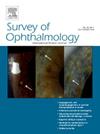小儿角膜炎
IF 5.1
2区 医学
Q1 OPHTHALMOLOGY
引用次数: 0
摘要
角膜炎是一种常见的小儿角膜疾病,可导致视力障碍和弱视。与成人角膜病相比,小儿角膜病起病较晚,病情发展迅速,角膜水肿等并发症的发病率较高,对儿童的生活质量有潜在影响。它通常在青春期出现,如果不及时治疗,会迅速发展到更严重的阶段。这种快速发展突显了通过对儿童群体进行定期筛查和对小儿角膜病疑似患者进行警惕性监测来进行早期诊断的重要性。伴发的眼部过敏、眼部异常、全身性疾病(如综合征)以及对隐形眼镜的依从性差可能会阻碍及时干预,并经常推迟康复。角膜胶原交联术是治疗小儿角膜塑形镜的关键干预措施,因为它能强化角膜微结构,阻止疾病的发展。当保守疗法无效时,角膜移植术仍是一种可行的选择,一般来说效果良好,但在术后护理方面存在独特的挑战,包括缝合、移植物长期存活以及需要在麻醉状态下反复检查等问题。眼科医生、验光师、儿科医生和其他医疗保健专业人员共同参与的多学科方法,注重早期诊断和及时干预,对于全面管理小儿角膜病和减轻其对儿童生活的影响至关重要。本文章由计算机程序翻译,如有差异,请以英文原文为准。
Pediatric keratoconus
Keratoconus is a common pediatric corneal disease, leading to vision impairment and amblyopia. Compared to its adult counterpart, pediatric keratoconus has an advanced presentation, rapid progression, higher incidence of complications such as corneal hydrops, and greater potential impact on the quality of life. It typically manifests during puberty and can evolve rapidly to more severe stages if left untreated. This rapid progression underscores the importance of early diagnosis through regular screening in pediatric populations and vigilant monitoring of pediatric keratoconus suspects. Concomitant ocular allergies, ocular anomalies, systemic diseases (e.g. syndromes), and poor compliance with contact lenses might impede prompt intervention and frequently postpone rehabilitation. Corneal collagen crosslinking is a crucial intervention in the management of pediatric keratoconus because it strengthens the corneal microstructure and halts the disease progression. When conservative measures fail, keratoplasty remains a viable option with generally favorable outcomes, though with unique challenges in post-operative care, including concerns related to sutures, long-term graft survival and need for repeated examinations under anesthesia. A multidisciplinary approach involving ophthalmologists, optometrists, pediatricians, and other healthcare professionals, focusing on early diagnosis and timely intervention, is essential for the comprehensive management of pediatric keratoconus and to mitigate its impact on children's lives.
求助全文
通过发布文献求助,成功后即可免费获取论文全文。
去求助
来源期刊

Survey of ophthalmology
医学-眼科学
CiteScore
10.30
自引率
2.00%
发文量
138
审稿时长
14.8 weeks
期刊介绍:
Survey of Ophthalmology is a clinically oriented review journal designed to keep ophthalmologists up to date. Comprehensive major review articles, written by experts and stringently refereed, integrate the literature on subjects selected for their clinical importance. Survey also includes feature articles, section reviews, book reviews, and abstracts.
 求助内容:
求助内容: 应助结果提醒方式:
应助结果提醒方式:


